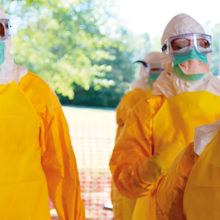Editorial
Issue: Halting Epidemics
07 February 2017 article

I would like to welcome everyone to the February edition of Microbiology Today, the first issue of 2017 and my first as Editor. I have enjoyed reading Microbiology Today over the years and always appreciated the wonderful diversity of topics it brings to its audience. I hope that we will continue to bring you varied and interesting articles to read. In that context I would like to say a huge thank-you to Laura Bowater and the Microbiology Today editorial team for all their help and advice during the handover of the editorship.
In the February issue we are taking a look at some of the many issues that surround halting epidemics. While epidemics are a problem in many parts of the world, they can often remain a relatively low-profile topic. More recently, however, the devastation that epidemics can cause when not monitored and contained successfully has been brought into sharp focus. The consequences of high-profile epidemics like Ebola and Zika have been the subject of intense global media attention.
The first article in this edition looks at how the accelerated use of technology can be used to reduce the impact of epidemics like these. This first-hand account, by Nicholas Loman, describes how the use of real-time data in an epidemic situation influenced the course of that epidemic. He recounts how real-time sequencing of Ebola genomes from newly diagnosed cases helped to pinpoint the likely source of those cases. He also outlines some of the challenges that need addressing to ensure that technology like this can be implemented in a timely manner for maximum effect when these health threats do occur.
Nicola Stonehouse and Oluwapelumi Adeyemi have written the second article addressing the question, ‘what are the prospects for the eradication of polio?’ They describe how this disease impacts on health around the world and outlines the challenges that are currently impeding global vaccination, including the limitations of current vaccines. They highlight the important research that is underway, investigating the possibilities of alternative vaccination strategies. The aim of this research is to develop a safe and effective vaccine, which in combination with a global immunisation plan could help us move towards a polio-free world.
The next article, written by Kate Baker, helps to clarify what it is that makes a disease endemic or epidemic, using shigellosis as an example. This piece summarises the important role that various factors such as host and environment can have in determining whether a disease becomes either endemic or epidemic. It also highlights how, due to the complex interactions between influencing factors, even a small shift in one of them can alter the balance of disease and so change its course.
Some diseases have a higher profile than others, but despite the severity of its symptoms and potentially high fatality rate, leishmaniasis remains a neglected disease in India and the Middle East. Lee Haines and Geraldine Foster from the Liverpool School of Tropical Medicine discuss the transmission, diagnosis, treatment and current ideas for control of this disease.
Stephen Baker gives an overview of the impact of zoonotic infections on public health. He shares first-hand experiences that demonstrate some of the problems associated with predicting the likely emergence and transmission patterns of emerging infectious diseases.
Finally, Michael Baron has written a Comment article on the eradication of rinderpest. He describes how it was possible to achieve the eradication of this disease using a combination of surveillance, diagnostics, education and vaccines. He also considers whether it could be possible to repeat this success to achieve the eradication of measles.
It is clear that epidemics have had a huge impact on public health throughout history, and that it is not always easy to predict where and when these outbreaks might occur. However, this edition demonstrates how developing technology and research, combined with education and surveillance, might go some way to addressing the challenges that epidemics bring.
Rowena Jenkins
Editor
[email protected]
Image: Medical personnel being trained in the proper protocols for Ebola virus prevention. CDC/Nahid Bhadelia, M.D./Science Photo Library..
